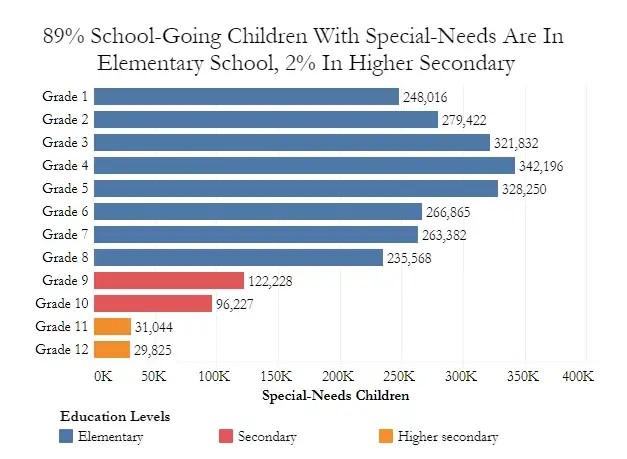
Anxiety disorders are the most common mental health disorders in children and adolescents. It is estimated that between 4-5% of all children and adolescents suffer from an anxiety disorder.
Most anxiety disorders are characterized by excessive worry and fear. These can lead to physical symptoms such as sweating, heart palpitations, and even chest pain. In severe cases, anxiety can be debilitating and make it hard for children to participate in school and social activities.
According to firstcrayon.com, in India, almost 89% of children with Special needs and with disorders like Generalized anxiety disorder (GAD) are in elementary school.

As a special education teacher and as a parent, you play a vital role in supporting students with anxiety disorders. Below we have shared some useful tips to help you provide the best possible support for your young learners.
In addition, if you’re a caring parent or a special education teacher who wants to learn more about how to take good care of specially-abled children then we do recommend our Online Special Education Courses, from which gain lots of insights and you can pursue this course on your terms in free time. Now, let’s get to know everything about Anxiety disorders and how to tackle them efficiently.
What are Anxiety Disorders?
Anxiety disorders are a group of mental health disorders characterized by excessive worry and fear. They can present differently in different people, but all involve the same worrying symptoms that can interfere with daily life.
Common anxiety disorders include generalized anxiety disorder (GAD), panic disorder, social anxiety disorder, and separation anxiety disorder. Each type of anxiety disorder affects people in different ways.
For example, those with Generalized anxiety disorder (GAD) may have intense and excessive worries that interfere with their daily routines. Those with panic disorder may experience sudden and unexpected panic attacks that can cause physical symptoms such as sweating or trembling.
Social anxiety disorder can cause extreme levels of shyness, worry, or self-consciousness in social situations. Separation anxiety can cause intense distress and worry when separated from specific people or places.
Useful Classroom Management Tips
1. Create an accepting environment:
Creating an environment in your classroom that is supportive and accepting of students who struggle with anxiety is considered to be one of the important anxiety-reducing teaching techniques. Model positive behaviour, use positive reinforcement with students, and create an overall calming atmosphere in the classroom, to help specially-abled students to deal with their anxiety and stress.
2. Develop an individualized behavioural plan:
Develop an individualized behavioural plan that includes strategies and interventions that are unique to the student’s specific needs. This plan should be tailored to the student’s individual needs and should incorporate accommodations to reduce stress and unwanted behaviours.
3. Incorporate relaxation techniques:
It is important to provide students with relaxation techniques that can help reduce anxiety and stress. This can include breathing techniques, progressive muscle relaxation, and mindfulness exercises.
4. Establish a consistent routine:
Establishing a consistent routine in the classroom can help reduce anxiety and stress in students. This includes a regular classroom schedule, consistent expectations for behavior, and providing an orderly learning environment.
5. Monitor triggers:
Pay attention to potential triggers that can increase anxiety levels in students. These can include noises, movements, and other environmental factors. Try to reduce or eliminate these triggers to help keep the overall environment as calm and anxiety-free as possible.
6. Monitor behaviours:
It is important to keep an eye out for any warning signs of anxiety and distress that may signal an upcoming panic attack, such as increased fidgeting, changes in breathing, or even avoidance behaviours.
7. Offer praise:
Offering praise is one of the great anxiety-reducing teaching techniques, which helps to boost self-esteem and help reduce anxiety in students. Always be sure to provide verbal praise and encouragement when appropriate, and recognize small successes throughout the school day.
8. Modify assignments:
Modifying assignments can be a great way to reduce anxiety in anxious students. For example, breaking a long assignment into smaller chunks can help reduce the feeling of being overwhelmed.
9. Incorporate flexibility:
Being flexible in the classroom can help reduce anxiety and stress in students. Use a flexible seating arrangement and allow students to take breaks when needed.
10. Practicing self-care:
Self-care is also important for special education teachers and parents who are working with students with anxiety disorders. Make sure to take time for yourself, as this can help to reduce stress and give you the energy needed to provide the best possible support for your students.
Final Thoughts
Anxiety disorders can be challenging and overwhelming for young learners, their parents, and teachers alike. As special education teachers and even parents, it is important to provide an accepting environment, develop an individualized behaviour plan, and incorporate various strategies and interventions to help and provide support to young learners. By following these above-mentioned classroom tips, you can provide the best possible support and help reduce the symptoms of anxiety in your students.
In case, if you’re a caring parent and a special education teacher who wants to learn more techniques to take care of specially-abled students, then we do recommend you to go through our online special education courses, which will definitely help you in your learning and teaching journey.
Get In Touch
UK – Registered OfficeAsian College Of Teachers Ltd (UK)
27, Old Gloucester Street, London – WC1N 3AX, UK
UK Toll Free: 0-808-189-1203
www.asiancollegeofteachers.co.uk
All SEN Courses are designed, developed and created by Asian College of Teachers Ltd, United Kingdom. These courses are certified by CPD Certification Service UK and endorsed by NCC Education, UK, and Short Courses from CACHE, UK through Laser Learning UK.
Asian College of Teachers (ACT) undertakes a continuous review of its teacher training courses to ensure imparting high quality education. However, there might be circumstances outside of ACT’s control which might affect its stakeholders like if you are planning to teach in a different country, applying for a teaching license, pursuing higher studies or trying to get the certificate approved by the Ministry of Education (MoE) of a particular country then you can do so with the certificate issued by Asian College of Teachers (ACT). However, each country’s Ministry of Education (MoE) or educational bodies set certain standards that are indispensable for the pursuit of higher studies or teaching in schools in that country. So it can be a possibility that you may be able to use the certificate for higher studies or teaching purposes in one country and not in another. Therefore, we strongly recommend that you investigate thoroughly and check with the relevant authorities regarding the acceptance of the certificate issued by us before you enrol on a particular course. ACT strives to offer high-quality education and its certificates can be valuable for various purposes internationally, but still it is crucial for individuals to verify the specific recognition of the certificate in the country they intend to use it, especially for formal education or professional licensing purposes. This approach ensures that the stakeholders make informed decisions regarding their educational and career paths.
© 2026 Asian College of Teachers. All Rights Reserved. Asian College Of Teachers is a trading brand of TTA Training Pvt. Ltd (India) - CIN U80902WB2016PTC215839, Asia Teachers Training Co., Ltd (Thailand) - Registration No. 0105558193360, Asian College Of Teachers Ltd (UK) - Company Number 9939942 & Asian College Of Teachers LLC, (USA) - Federal Tax Identification Number 30-1261596
Designed by kreativewebtech